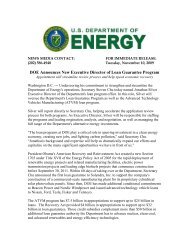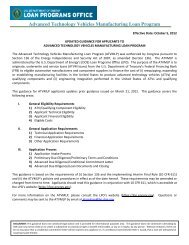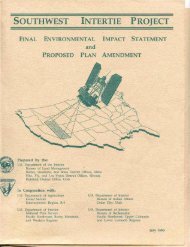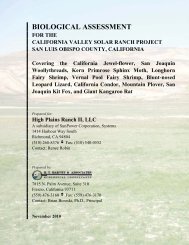Bureau of Land Management's Decision Record and Environmental
Bureau of Land Management's Decision Record and Environmental
Bureau of Land Management's Decision Record and Environmental
You also want an ePaper? Increase the reach of your titles
YUMPU automatically turns print PDFs into web optimized ePapers that Google loves.
Jersey Valley Geothennal Development Project<br />
<strong>Environmental</strong> Assessment: NV063 -EAO8-09 1<br />
The NDWR lists eight points <strong>of</strong> diversion for surface water rights located within the Jersey<br />
Valley unit area. One <strong>of</strong> these is a certified irrigation right <strong>of</strong> 44.16 AFY from a stream source<br />
located on private l<strong>and</strong> in Section 34. The remaining seven are vested stock water rights totaling<br />
237.72 AFY from springs located in Sections 28 <strong>and</strong> 29 which are associated with the Jersey Hot<br />
Springs (NDCNR-DWR 2009b).<br />
Ormat has collected <strong>and</strong> analyzed samples <strong>of</strong> geothermal fluid from several <strong>of</strong> the geothermal<br />
wells drilled <strong>and</strong> flow-tested by Ormat as part <strong>of</strong> its exploration <strong>of</strong> the Jersey Valley unit area.<br />
These produced geotheimal fluids are, like the Jersey Hot Springs, a sodium chloride/calcium<br />
sulfate water, but with a substantially higher TDS concentration (approximately 2,600 ppm)<br />
(Ormat 2008) (see Table 8). Boron concentrations averaged about 2.21 ppm.<br />
3.9.2 <strong>Environmental</strong> Consequences<br />
3.9.2.1 Proposed Action<br />
The geothermal wells would be drilled using non-toxic drilling mud to prevent the loss <strong>of</strong><br />
drilling fluids into the rock <strong>and</strong> the risk <strong>of</strong> contamination to any aquifers from the drilling fluid.<br />
Reserve pits would be constructed at each well site for the containment <strong>and</strong> temporary storage <strong>of</strong><br />
drilling mud, drill cuttings, geothermal fluid <strong>and</strong> storm water run<strong>of</strong>f from each constructed well<br />
pad. Because non-toxic drilling mud would be used, the reserve pits are not proposed to be lined.<br />
Additionally, the bentonite drilling muds discharged into the reserve pits would tend to act as a<br />
liner, in the same way they prevent the loss <strong>of</strong> drilling fluids in the well bore into the rock.<br />
Therefore, contamination <strong>of</strong> the local ground water aquifers as a result <strong>of</strong> the temporary<br />
discharges into the reserve pits is unlikely.<br />
Over the operational life <strong>of</strong> the project, accidental discharges <strong>of</strong> geothermal fluids could<br />
contaminate surface or ground waters. However, these are unlikely because <strong>of</strong> the frequent<br />
inspections <strong>and</strong> ultrasonic testing <strong>of</strong> the geothermal pipelines, the pipeline flow <strong>and</strong> pressure<br />
monitoring <strong>and</strong> the well pump <strong>and</strong> pipeline valve shutdown features. Contamination <strong>of</strong> surface or<br />
ground waters from spills <strong>of</strong> petroleum products (such as diesel fuel or lubricants) is also<br />
unlikely because the well pads <strong>and</strong> power plant sites, where most petroleum products would be<br />
used <strong>and</strong> stored, would be bermed to contain <strong>and</strong> control any spills. The project includes the<br />
development <strong>of</strong> a spill <strong>and</strong> disposal contingency plan which would describe the methods for<br />
cleanup <strong>and</strong> abatement <strong>of</strong> any petroleum hydrocarbon or other hazardous material spill.<br />
During construction, the Jersey Valley Project would consume about 105 acre-feet <strong>of</strong> ground<br />
water over the anticipated 12-month construction period, principally for geothermal well drilling<br />
<strong>and</strong> dust control. This one-time quantity <strong>of</strong> construction water, obtained from existing private<br />
water well source, is substantially less than the perennial yield estimated for the basin. Thus,<br />
there is little potential for creating any adverse affects on the quantity <strong>of</strong> either surface waters or<br />
ground waters in or adjacent to the geothermal operations area. The following monitoring<br />
measure is proposed for the Jersey Valley project to verify the absence <strong>of</strong> adverse effects on the<br />
quantity <strong>and</strong> quality <strong>of</strong> ground waters.<br />
- 67 -







